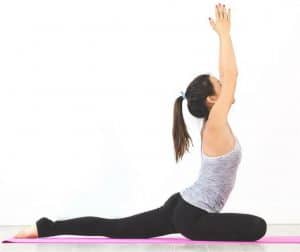Yoga originates from India and it consists both spiritual and physical characteristics. Yoga involves certain type of diet, meditation routine, breathing techniques (pranayamas) and body postures and practices (asanas) (1).
There are many different types of yoga, as they are diverse schools of yoga, such as vinyasa, Ashtanga, Iyengar, Bikram and many more. Yoga has been proven to be highly advantageous not only to the body and but also to the mind, as it improves the quality of mind and reduces stress.
This article discusses not only the gains of yoga but also demonstrates how combining yoga with keto diet can prove beneficial to your health.
How Yoga Together with Ketogenic Diet Can Improve Your Health
Many people have successfully used yoga as a form of exercise when they’re on the keto diet to tone up their body and improve coordination, balance and flexibility.
Here we have listed the top health benefits of doing yoga, and how some of these benefits are also similar to the benefits of keto diet. You can definitely incorporate yoga with any diet. You can’t go wrong with yoga.
#1. Reduces anxiety and stress

Practising yoga has been proven to help in anxiety and stress reduction. Based on a study conducted in India among 70 people with chronic periodontitis, it was demonstrated that the group of patients who practised yoga had lower scores in the anxiety and the depression scales (2, 3).
Another study in Philadelphia showed that yoga practice results in lower anxiety scores and improved quality of life (4).
Yoga is even more beneficial to women, as it can act as a stress-management tool among breast-cancer patients undergoing radiotherapy and as a treatment for women with posttraumatic stress disorder (PTSD) (5, 6, 7).
Even for women suffering from anxiety disorder, yoga has proven effective in reducing both trait and state anxiety (8, 9).
#2. Improves sleep quality
Yoga practice has also been demonstrated to reduce sleep disturbances and improve quality of sleep. According to a study conducted in China among 120 nurses, the group which practiced yoga twice a week or more for around 50 minutes after work had a better quality of sleep and less work-related stress compared to the non-yoga group (10).
Yoga practice can be particularly useful among patients with cancer. Based on a US study among 39 patients with lymphoma, the patients who followed Tibetan yoga sessions reported better quality of sleep, faster sleep abeyance and lengthier periods of sleep as opposed to the control group (11).
Cancer survivors also benefit from yoga classes, as shown by a multicenter, randomized controlled trial on 410 cancer survivors suffering from sleep disturbances. The yoga group displayed better-improved sleep quality and efficiency and decreased daytime dysfunction compared to the control group (12).
#3. Could reduce pain

Yoga can reduce anxiety, stress and improve sleep quality but can also help with chronic pain and surgery-related pain. More specifically, yoga can help in pain reduction among people with rheumatoid arthritis, migraine, back pain and other indications (13).
In a study on 112 postoperative cardiac patients who followed yoga sessions twice a week, 89.2% of the participants reported that yoga classes help with the pain after surgery (14).
This view is further supported by a randomized trial among 313 adults with chronic or recurring back pain. The yoga group had improved back function in 3, 6 and 12 months as opposed to the usual care group. Yoga participants also reported lower disability scores and higher pain self-efficacy scores (15).
Yoga can take many forms, and one of them is “chair yoga” which is designed for people who have difficulties standing. Chair yoga also proved beneficial towards back pain according to a randomized, controlled trial among 112 older adults suffering from lower extremity osteoarthritis. The chair yoga group demonstrated higher pain and fatigue reduction than the control group (16).
#4. Promotes cardiovascular health
Yoga, through its asanas and pranayamas, has the potential to improve cardiovascular health. A prospective, controlled, open trial among 114 patients with coronary artery disease showed that the group practising yoga resulted in higher coronary lesions reduction, disease regression and cholesterol levels compared to the control group (17).
Another study on 19 chronic heart failure patients demonstrated that the yoga group had enhanced exercise capacity and improved inflammatory markers than the standard medical therapy group (18).
Yoga can also help in promotion of the cardiac health and prevention of cardiovascular diseases. Yoga practice among young, healthy males can increase cardiorespiratory performance and melatonin secretion, which is directly linked to well-being (19).
But even among older adults yoga can be beneficial. Adults over 40, who have been practising yoga for 5 years compared to people physically inactive have lower systolic and diastolic blood pressure, one of the main risk factors of cardiac diseases (20).
#5. Increases flexibility and balance

Yoga can be a great way to improve flexibility and balance. Based on an Australian, blinded, randomized study on 54 older adults, 12-week Iyengar yoga practice resulted in better standing balance, improved sit-to-stand test and one-legged-stand-with-eyes closed test compared to the control group (21).
Another study among elderly showed that one year of yoga practice can increase flexibility even four times more than a year of callisthenics, a body weight training and twenty times more than no physical exercise at all (22).
Although most studies examine the effect of yoga on patients and older generations, yoga practice can also be beneficial to healthy and athletic people. According to a recent study among 14 college athletes, the group which practiced yoga bi-weekly reported increased flexibility and balance as opposed to the control group (23).
Thus, yoga may be used to improve athletic performance. Bikram yoga, in particular, can improve balance, leg strength lower back/hamstring and shoulder flexibility among the young population (24, 25).
#6. Enhances quality of life
Yoga helps in stress relief and pain reduction while it can improve sleep quality, flexibility and heart health. It comes as no surprise that yoga practice is often associated with enhanced quality of life. More specifically, yoga is proven that it can increase health-related quality of life and reduce mood disturbance among cancer survivors (26).
Hatha yoga practice has also been linked with enhanced quality of life and increased well-being indicators compared to exercise and wait-list control groups among healthy older population (27).
Another study among 120 seniors living in elderly homes demonstrated that the group who practiced yoga had better sleep quality and higher quality of life scores compared to the control group (28).
Last but not least, a study among 102 pregnant women in Bangalore showed that the yoga group not only reported better quality of life but also improved aspects in interpersonal relationships compared to the control group (29).
#7. Helps in weight loss

Yoga can be helpful in weight loss and obesity management. Many clinical trials have been conducted demonstrating that yoga can successfully reduce weight, waist circumference and body fat (30).
Yoga practice is particularly helpful for people who have difficulty losing weight and among middle-aged adults. A 10-week, bi-weekly yoga programme consisting of 37 overweight and obese adults resulted in significant weight loss and enhanced phycological state (31, 32, 33).
However, yoga is not the only alternative intervention for effective weight loss. The keto diet, a diet consisting of high fat and low carbohydrate intake, can also help you lose weight.
Based on a study conducted on 17 American obese men, the group which followed a Ketogenic diet for a month, demonstrated significant weight loss and reduced feelings of hunger. The group which followed a non-ketogenic diet in the same study was less successful (34).
According to a clinical trial conducted in New Zealand among 118 obese adults, a ketogenic diet not only resulted in great weight loss, but also in a significant decrease in triglycerides (35).
It can be argued that a combination of yoga practice and ketogenic diet could prove even more effective in the reduction of body weight and the successful prevention of overweight and obesity.
#8. Has an anti-inflammatory effect
Although yoga is mostly associated with boosted flexibility and stress reduction, it provides another great gain; anti-inflammation. People who have been practising yoga weekly or bi-weekly for over two years have demonstrated lower levels of inflammatory interleukin-6 (IL-6) compared to people who have practiced 12 or less times yoga in their entire lives (36).
Furthermore, practice of Hatha yoga ensues heightened levels of the anti-inflammatory protein adiponectin and reduced levels of the pro-inflammatory marker leptin (37).
More importantly, yoga has demonstrated beneficial effects among people with different types of diseases. According to a study conducted in India on 86 patients with chronic inflammatory diseases, yoga intervention programme resulted in lower levels of IL-6 and tumour necrosis factor in the first 10 days of the trial (38)!
Moreover, yoga practice can increase inflammatory markers among patients with chronic heart failure and enhanced anti-inflammatory glucocorticoid receptor activity among breast cancer survivors (39, 40).
Ketogenic diet has also demonstrated anti-inflammatory effects. It has been proven to decrease pro-inflammatory cytokines (interleukin-1 beta, interleukin-6, and tumour necrosis factor-alpha) and being anti-inflammatory against MPTP-neurotoxicity (41).
It is also beneficial against multiple sclerosis, as it can supress expression of inflammatory cytokines and chemokines (42).
Furthermore, a specific type of ketogenic diet, the Spanish Ketogenic Mediterranean Diet has demonstrated reduced liver inflammation among adults suffering from metabolic syndrome and non-alcoholic fatty liver disease (43).
As yoga practice and ketogenic diet have been scientifically proven to fight inflammation, the combination of these two alternative interventions is prone to successfully guard the body.
#9. Benefits the nervous system
Human’s nervous system consists of the parasympathetic nervous system and the sympathetic nervous system. The parasympathetic nervous system is responsible for the breathing, metabolism, heart, digestion and controls other body systems as well (44).
The passive pace and deep breathing of yoga does not only activate the parasympathetic nervous system but also decreases the tendency to provoke the sympathetic nervous system, thus reducing the stress levels, lowering blood pressure and achieving balance (45).
Yoga could also be effective as epilepsy treatment, as according to a clinical trial consisting of 32 epileptic adults, the group which practiced yoga demonstrated lower number of attacks and reduced severity of seizures as opposed to the control groups (46).
The decreased magnitude of seizures can be attributed to the enhanced parasympathetic nervous system activity, reduced stress and anxiety levels and elevated thalamic gamma amino-butyric acid (GABA) levels, all of which are yoga practice outcomes (47).
It is known that ketogenic diet can be utilised as epilepsy treatment, as this was the main reason Wilder invented it in 1921. Ketogenic diet can induce ketosis and has been proven to reduce seizures among children suffering from refractory epilepsy (48).
Besides epilepsy, ketogenic diet has proved to be an effective treatment against other neurodegenerative diseases, such as Alzeheimer’s, Parkison’s disease, amyotrophic lateral sclerosis and a variety of mitochondriopathies (49).
Moreover, ketogenic diet possess antioxidant properties which reduce the frequency and the magnitude of seizures and also has demonstrated a positive effect on neurotransmitters (50).
The antioxidant and neuroprotective attributes of the ketogenic diet together with the ability of yoga to activate the parasympathetic nervous system are inclined not only to protect the nervous system but also to provide balance and clarity of mind.
#10. Could reduce risk of diabetes type 2
Diabetes is a major health problem and has many risk factors, including but not limited to: obesity, stress, anxiety, increased blood pressure, increased cholesterol and many more (51).
Yoga practice can assist in preventing the risk of developing diabetes type 2, as via yoga postures and asanas, many risk factors of diabetes can be reduced significantly.
A study conducted in India among 41 adults, demonstrated that yoga practice resulted in decreased levels of systolic and diastolic blood pressure, total cholesterol levels and reduced feelings of anxiety, depression, and perceived stress. Moreover, the group which practiced yoga showed greater decreases in weight loss, BMI and waist circumference reduction compared to the control group which was involved in walking sessions (52).
Another study among 20 type 2 diabetic adults showed that yoga asanas resulted in lower glucose levels, reduced waist-hip ratio and insulin levels alterations (53).
More evidence on effective type 2 diabetes management due to yoga asanas and pranayamas is provided by a study conducted in India among 60 patients suffering from diabetes type 2. This 45-day study demonstrated that yoga practice resulted in greater decreases in blood glucose levels, lipid profile and serum insulin levels compared to the control group (54).
Although ketogenic diet is rich in fat and not an obvious choice for diabetes diet, the body converts fat instead of sugar into energy. In other words, ketogenic diet has the potential to decrease the need for insulin while in parallel improve the blood glucose levels.
Further evidence on ketogenic diet being beneficial among adults with type 2 diabetes is provided by a study conducted in Kuwait among 363 obese and overweight and diabetic patients. The group following a ketogenic diet demonstrated greater reductions in weight loss and improved glycaemia compared to the group following a low-calorie diet (55).
According to another study recruiting 84 people suffering from obesity and diabetes type 2 in the US, the ketogenic diet group displayed greater increases in hemoglobin A1c body weight and more significant weight loss as opposed to the control group following a low-glycaemic, reduced-calorie diet (56).
Studies have demonstrated the improved clinical outcomes of yoga practice interventions but also ketogenic diet programmes among people with obesity and diabetes type 2. One could assert that a combination of the both interventions could assist in the prevention and management of diabetes mellitus.
Food for thought
Yoga and ketogenic diet have been the center of many clinical trials and scientific studies. Their benefits range from stress and anxiety reduction to fighting inflammation and treating epilepsy and diabetes type 2. Combining yoga practice with ketogenic diet could prove highly beneficial to your health, your body and your mind.
If you find this article useful, feel free to share it with your friends or save this post by pinning this picture below to your Pinterest board for later reference.








